stop start FIAT PALIO 2003 178 / 1.G India Version Owners Manual
[x] Cancel search | Manufacturer: FIAT, Model Year: 2003, Model line: PALIO, Model: FIAT PALIO 2003 178 / 1.GPages: 156, PDF Size: 6.27 MB
Page 22 of 156
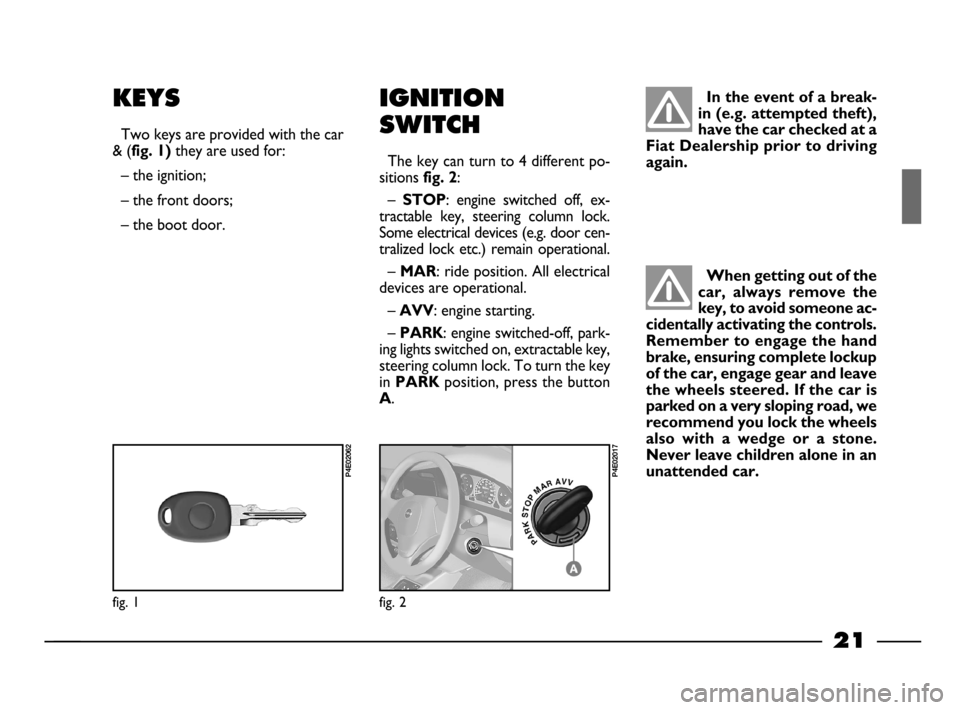
21
IGNITION
SWITCH
The key can turn to 4 different po-
sitions
fig. 2:
–
STOP: engine switched off, ex-
tractable key, steering column lock.
Some electrical devices (e.g. door cen-
tralized lock etc.) remain operational.
–
MAR: ride position. All electrical
devices are operational.
–
AVV: engine starting.
–
PARK: engine switched-off, park-
ing lights switched on, extractable key,
steering column lock. To turn the key
in
PARK position, press the button
A.
In the event of a break-
in (e.g. attempted theft),
have the car checked at a
Fiat Dealership prior to driving
again.
fig. 1
P4E02062
KEYS
Two keys are provided with the car
& (
fig. 1) they are used for:
– the ignition;
– the front doors;
– the boot door.
Together with the keys, a self-stick
label is supplied. On this label is re-
ported the number to be quoted to
Fiat Dealershipwhen ordering du-
plicate keys.
fig. 2
P4E02017
When getting out of the
car, always remove the
key, to avoid someone ac-
cidentally activating the controls.
Remember to engage the hand
brake, ensuring complete lockup
of the car, engage gear and leave
the wheels steered. If the car is
parked on a very sloping road, we
recommend you lock the wheels
also with a wedge or a stone.
Never leave children alone in an
unattended car.
20-63 03/03/2003 06:02 PM Page 21
Page 36 of 156
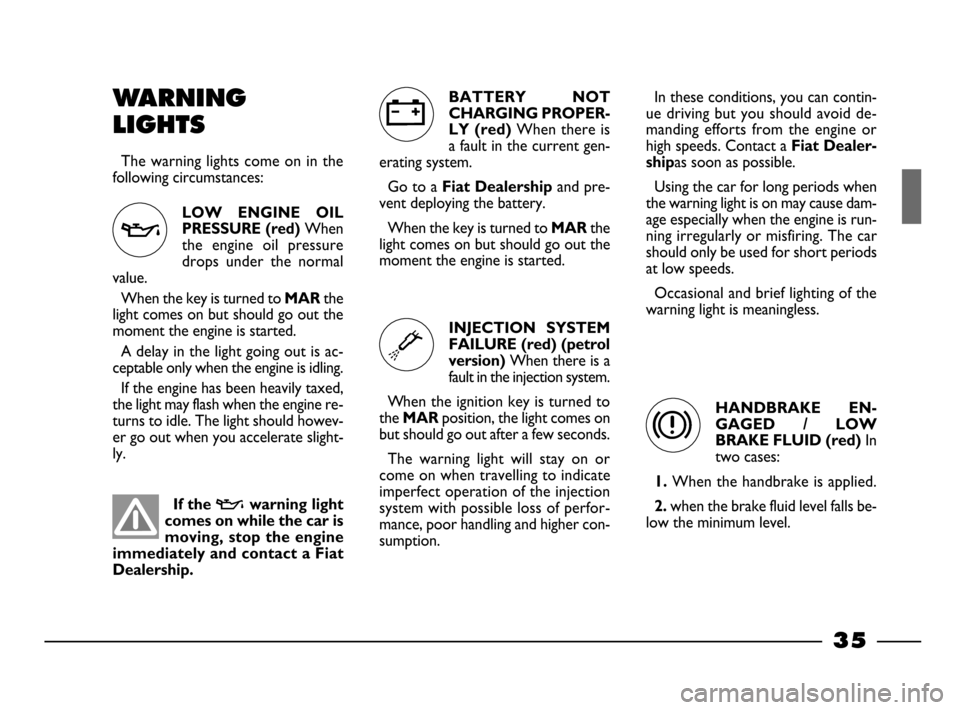
35
WARNING
LIGHTS
The warning lights come on in the
following circumstances:
BATTERY NOT
CHARGING PROPER-
LY (red)
When there is
a fault in the current gen-
erating system.
Go to a
Fiat Dealershipand pre-
vent deploying the battery.
When the key is turned to
MAR the
light comes on but should go out the
moment the engine is started.
LOW ENGINE OIL
PRESSURE (red)
When
the engine oil pressure
drops under the normal
value.
When the key is turned to
MARthe
light comes on but should go out the
moment the engine is started.
A delay in the light going out is ac-
ceptable only when the engine is idling.
If the engine has been heavily taxed,
the light may flash when the engine re-
turns to idle. The light should howev-
er go out when you accelerate slight-
ly.
v
w
If the vwarning light
comes on while the car is
moving, stop the engine
immediately and contact a Fiat
Dealership.
INJECTION SYSTEM
FAILURE (red) (petrol
version)
When there is a
fault in the injection system.
When the ignition key is turned to
the
MAR position, the light comes on
but should go out after a few seconds.
The warning light will stay on or
come on when travelling to indicate
imperfect operation of the injection
system with possible loss of perfor-
mance, poor handling and higher con-
sumption.
g
In these conditions, you can contin-
ue driving but you should avoid de-
manding efforts from the engine or
high speeds. Contact a
Fiat Dealer-
ship
as soon as possible.
Using the car for long periods when
the warning light is on may cause dam-
age especially when the engine is run-
ning irregularly or misfiring. The car
should only be used for short periods
at low speeds.
Occasional and brief lighting of the
warning light is meaningless.
HANDBRAKE EN-
GAGED / LOW
BRAKE FLUID (red)
In
two cases:
1.When the handbrake is applied.
2. when the brake fluid level falls be-
low the minimum level.
x
20-63 03/03/2003 06:02 PM Page 35
Page 66 of 156
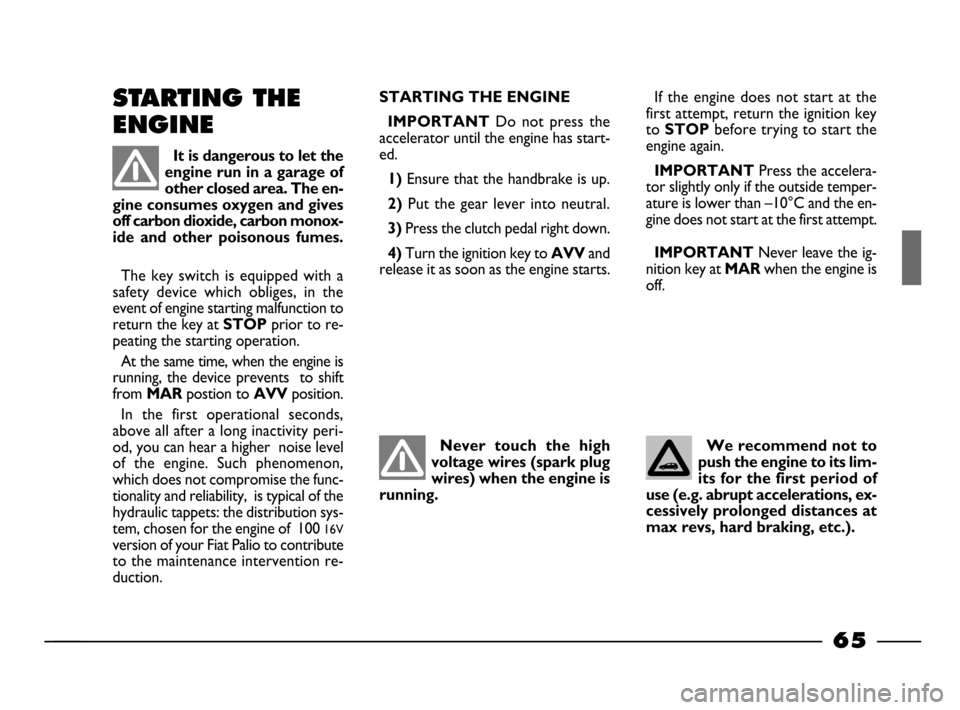
65
The key switch is equipped with a
safety device which obliges, in the
event of engine starting malfunction to
return the key at
STOP prior to re-
peating the starting operation.
At the same time, when the engine is
running, the device prevents to shift
from
MAR postion to AVV position.
In the first operational seconds,
above all after a long inactivity peri-
od, you can hear a higher noise level
of the engine. Such phenomenon,
which does not compromise the func-
tionality and reliability, is typical of the
hydraulic tappets: the distribution sys-
tem, chosen for the engine of 100
16V
version of your Fiat Palio to contribute
to the maintenance intervention re-
duction.
STARTING THE ENGINE
IMPORTANT
Do not press the
accelerator until the engine has start-
ed.
1) Ensure that the handbrake is up.
2) Put the gear lever into neutral.
3)Press the clutch pedal right down.
4) Turn the ignition key to AVVand
release it as soon as the engine starts.If the engine does not start at the
first attempt, return the ignition key
to
STOP before trying to start the
engine again.
IMPORTANT Press the accelera-
tor slightly only if the outside temper-
ature is lower than –10°C and the en-
gine does not start at the first attempt.
IMPORTANTNever leave the ig-
nition key at
MARwhen the engine is
off.
Never touch the high
voltage wires (spark plug
wires) when the engine is
running.
It is dangerous to let the
engine run in a garage of
other closed area. The en-
gine consumes oxygen and gives
off carbon dioxide, carbon monox-
ide and other poisonous fumes.
STARTING THE
ENGINE
We recommend not to
push the engine to its lim-
its for the first period of
use (e.g. abrupt accelerations, ex-
cessively prolonged distances at
max revs, hard braking, etc.).
64-79 03/03/2003 06:45 PM Page 65
Page 67 of 156
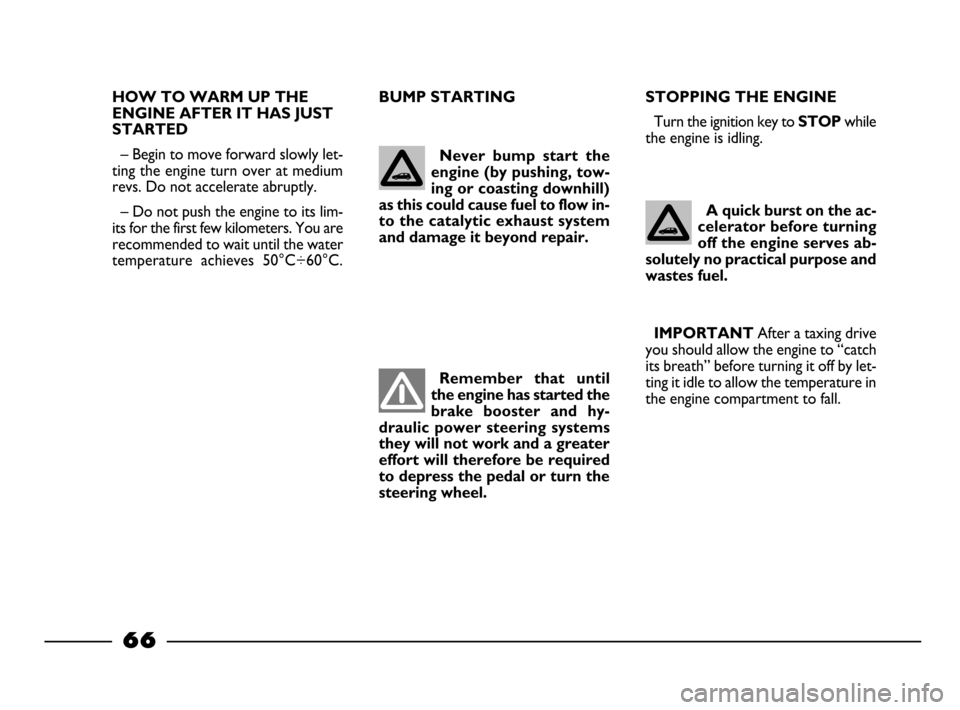
66
BUMP STARTING STOPPING THE ENGINE
Turn the ignition key to STOPwhile
the engine is idling.
HOW TO WARM UP THE
ENGINE AFTER IT HAS JUST
STARTED
– Begin to move forward slowly let-
ting the engine turn over at medium
revs. Do not accelerate abruptly.
– Do not push the engine to its lim-
its for the first few kilometers. You are
recommended to wait until the water
temperature achieves 50°C÷60°C.
Remember that until
the engine has started the
brake booster and hy-
draulic power steering systems
they will not work and a greater
effort will therefore be required
to depress the pedal or turn the
steering wheel.Never bump start the
engine (by pushing, tow-
ing or coasting downhill)
as this could cause fuel to flow in-
to the catalytic exhaust system
and damage it beyond repair.
A quick burst on the ac-
celerator before turning
off the engine serves ab-
solutely no practical purpose and
wastes fuel.
IMPORTANT
After a taxing drive
you should allow the engine to “catch
its breath” before turning it off by let-
ting it idle to allow the temperature in
the engine compartment to fall.
64-79 03/03/2003 06:45 PM Page 66
Page 72 of 156
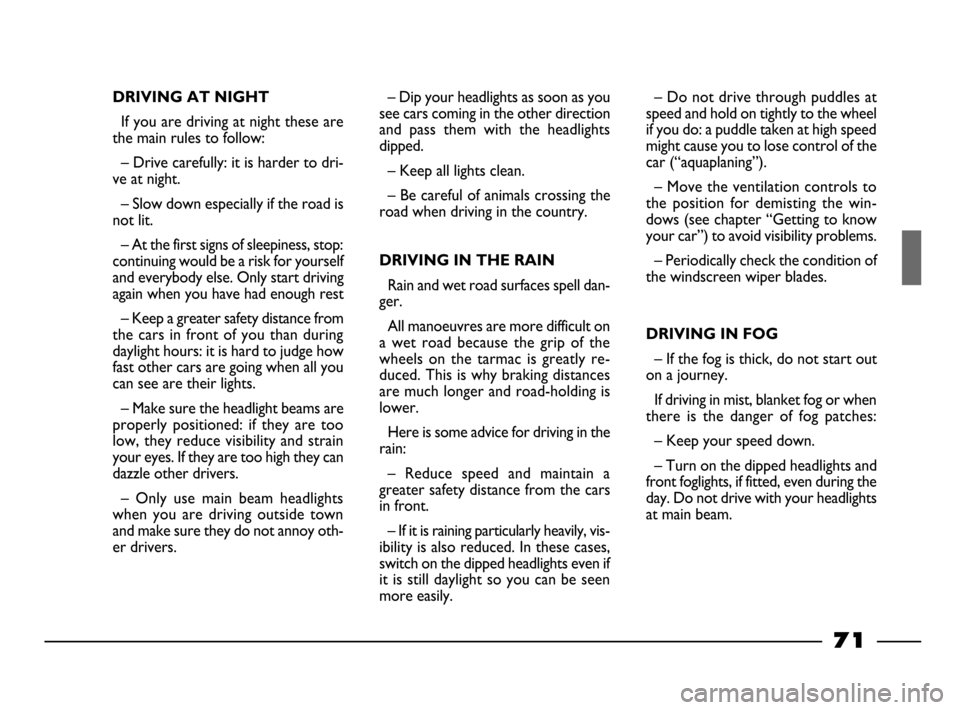
71
DRIVING AT NIGHT
If you are driving at night these are
the main rules to follow:
– Drive carefully: it is harder to dri-
ve at night.
– Slow down especially if the road is
not lit.
– At the first signs of sleepiness, stop:
continuing would be a risk for yourself
and everybody else. Only start driving
again when you have had enough rest
– Keep a greater safety distance from
the cars in front of you than during
daylight hours: it is hard to judge how
fast other cars are going when all you
can see are their lights.
– Make sure the headlight beams are
properly positioned: if they are too
low, they reduce visibility and strain
your eyes. If they are too high they can
dazzle other drivers.
– Only use main beam headlights
when you are driving outside town
and make sure they do not annoy oth-
er drivers.– Dip your headlights as soon as you
see cars coming in the other direction
and pass them with the headlights
dipped.
– Keep all lights clean.
– Be careful of animals crossing the
road when driving in the country.
DRIVING IN THE RAIN
Rain and wet road surfaces spell dan-
ger.
All manoeuvres are more difficult on
a wet road because the grip of the
wheels on the tarmac is greatly re-
duced. This is why braking distances
are much longer and road-holding is
lower.
Here is some advice for driving in the
rain:
– Reduce speed and maintain a
greater safety distance from the cars
in front.
– If it is raining particularly heavily, vis-
ibility is also reduced. In these cases,
switch on the dipped headlights even if
it is still daylight so you can be seen
more easily. – Do not drive through puddles at
speed and hold on tightly to the wheel
if you do: a puddle taken at high speed
might cause you to lose control of the
car (“aquaplaning”).
– Move the ventilation controls to
the position for demisting the win-
dows (see chapter “Getting to know
your car”) to avoid visibility problems.
– Periodically check the condition of
the windscreen wiper blades.
DRIVING IN FOG
– If the fog is thick, do not start out
on a journey.
If driving in mist, blanket fog or when
there is the danger of fog patches:
– Keep your speed down.
– Turn on the dipped headlights and
front foglights, if fitted, even during the
day. Do not drive with your headlights
at main beam.
64-79 03/03/2003 06:45 PM Page 71
Page 73 of 156
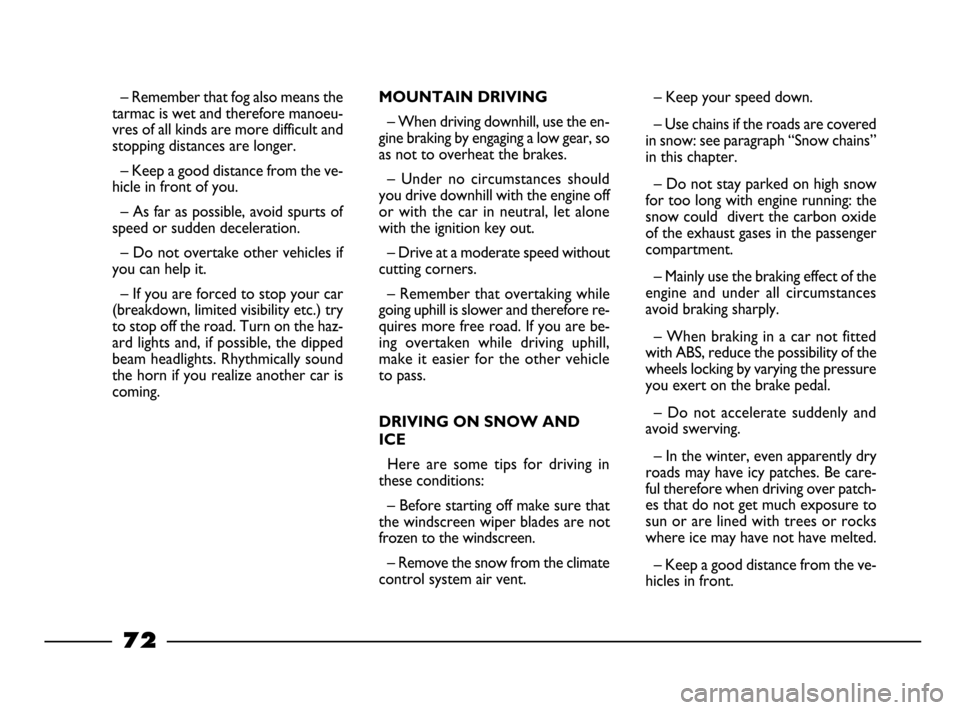
72
– Remember that fog also means the
tarmac is wet and therefore manoeu-
vres of all kinds are more difficult and
stopping distances are longer.
– Keep a good distance from the ve-
hicle in front of you.
– As far as possible, avoid spurts of
speed or sudden deceleration.
– Do not overtake other vehicles if
you can help it.
– If you are forced to stop your car
(breakdown, limited visibility etc.) try
to stop off the road. Turn on the haz-
ard lights and, if possible, the dipped
beam headlights. Rhythmically sound
the horn if you realize another car is
coming.MOUNTAIN DRIVING
– When driving downhill, use the en-
gine braking by engaging a low gear, so
as not to overheat the brakes.
– Under no circumstances should
you drive downhill with the engine off
or with the car in neutral, let alone
with the ignition key out.
– Drive at a moderate speed without
cutting corners.
– Remember that overtaking while
going uphill is slower and therefore re-
quires more free road. If you are be-
ing overtaken while driving uphill,
make it easier for the other vehicle
to pass.
DRIVING ON SNOW AND
ICE
Here are some tips for driving in
these conditions:
– Before starting off make sure that
the windscreen wiper blades are not
frozen to the windscreen.
– Remove the snow from the climate
control system air vent. – Keep your speed down.
– Use chains if the roads are covered
in snow: see paragraph “Snow chains”
in this chapter.
– Do not stay parked on high snow
for too long with engine running: the
snow could divert the carbon oxide
of the exhaust gases in the passenger
compartment.
– Mainly use the braking effect of the
engine and under all circumstances
avoid braking sharply.
– When braking in a car not fitted
with ABS, reduce the possibility of the
wheels locking by varying the pressure
you exert on the brake pedal.
– Do not accelerate suddenly and
avoid swerving.
– In the winter, even apparently dry
roads may have icy patches. Be care-
ful therefore when driving over patch-
es that do not get much exposure to
sun or are lined with trees or rocks
where ice may have not have melted.
– Keep a good distance from the ve-
hicles in front.
64-79 03/03/2003 06:45 PM Page 72
Page 77 of 156
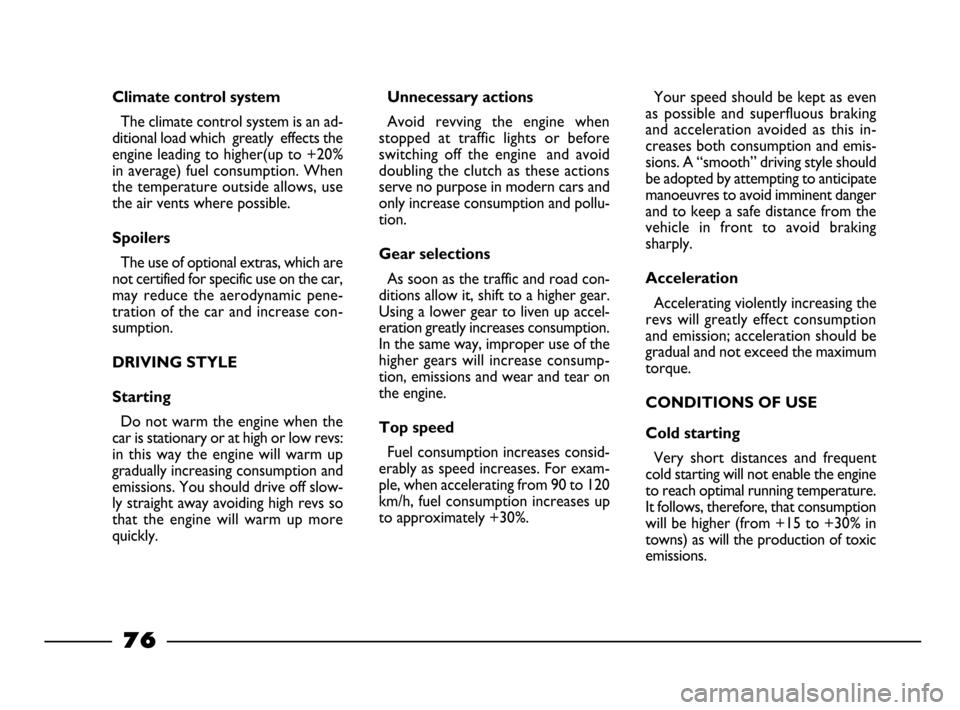
76
Climate control system
The climate control system is an ad-
ditional load which greatly effects the
engine leading to higher(up to +20%
in average) fuel consumption. When
the temperature outside allows, use
the air vents where possible.
Spoilers
The use of optional extras, which are
not certified for specific use on the car,
may reduce the aerodynamic pene-
tration of the car and increase con-
sumption.
DRIVING STYLE
Starting
Do not warm the engine when the
car is stationary or at high or low revs:
in this way the engine will warm up
gradually increasing consumption and
emissions. You should drive off slow-
ly straight away avoiding high revs so
that the engine will warm up more
quickly.
Unnecessary actions
Avoid revving the engine when
stopped at traffic lights or before
switching off the engine and avoid
doubling the clutch as these actions
serve no purpose in modern cars and
only increase consumption and pollu-
tion.
Gear selections
As soon as the traffic and road con-
ditions allow it, shift to a higher gear.
Using a lower gear to liven up accel-
eration greatly increases consumption.
In the same way, improper use of the
higher gears will increase consump-
tion, emissions and wear and tear on
the engine.
Top speed
Fuel consumption increases consid-
erably as speed increases. For exam-
ple, when accelerating from 90 to 120
km/h, fuel consumption increases up
to approximately +30%. Your speed should be kept as even
as possible and superfluous braking
and acceleration avoided as this in-
creases both consumption and emis-
sions. A “smooth” driving style should
be adopted by attempting to anticipate
manoeuvres to avoid imminent danger
and to keep a safe distance from the
vehicle in front to avoid braking
sharply.
Acceleration
Accelerating violently increasing the
revs will greatly effect consumption
and emission; acceleration should be
gradual and not exceed the maximum
torque.
CONDITIONS OF USE
Cold starting
Very short distances and frequent
cold starting will not enable the engine
to reach optimal running temperature.
It follows, therefore, that consumption
will be higher (from +15 to +30% in
towns) as will the production of toxic
emissions.
64-79 03/03/2003 06:45 PM Page 76
Page 102 of 156
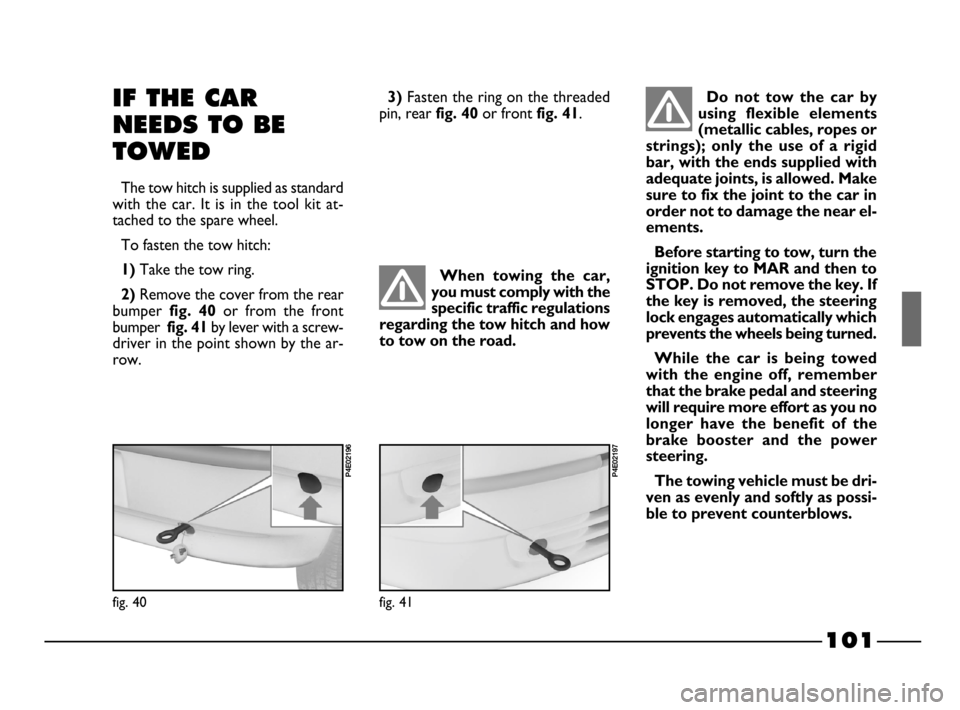
101
Do not tow the car by
using flexible elements
(metallic cables, ropes or
strings); only the use of a rigid
bar, with the ends supplied with
adequate joints, is allowed. Make
sure to fix the joint to the car in
order not to damage the near el-
ements.
Before starting to tow, turn the
ignition key to MAR and then to
STOP. Do not remove the key. If
the key is removed, the steering
lock engages automatically which
prevents the wheels being turned.
While the car is being towed
with the engine off, remember
that the brake pedal and steering
will require more effort as you no
longer have the benefit of the
brake booster and the power
steering.
The towing vehicle must be dri-
ven as evenly and softly as possi-
ble to prevent counterblows.IF THE CAR
NEEDS TO BE
TOWED
The tow hitch is supplied as standard
with the car. It is in the tool kit at-
tached to the spare wheel.
To fasten the tow hitch:
1)Take the tow ring.
2) Remove the cover from the rear
bumper
fig. 40or from the front
bumper
fig. 41by lever with a screw-
driver in the point shown by the ar-
row.
fig. 40
P4E02196
fig. 41
P4E02197
When towing the car,
you must comply with the
specific traffic regulations
regarding the tow hitch and how
to tow on the road.
3)Fasten the ring on the threaded
pin, rear
fig. 40or front fig. 41.
80-103 03/03/2003 06:49 PM Page 101
Page 123 of 156
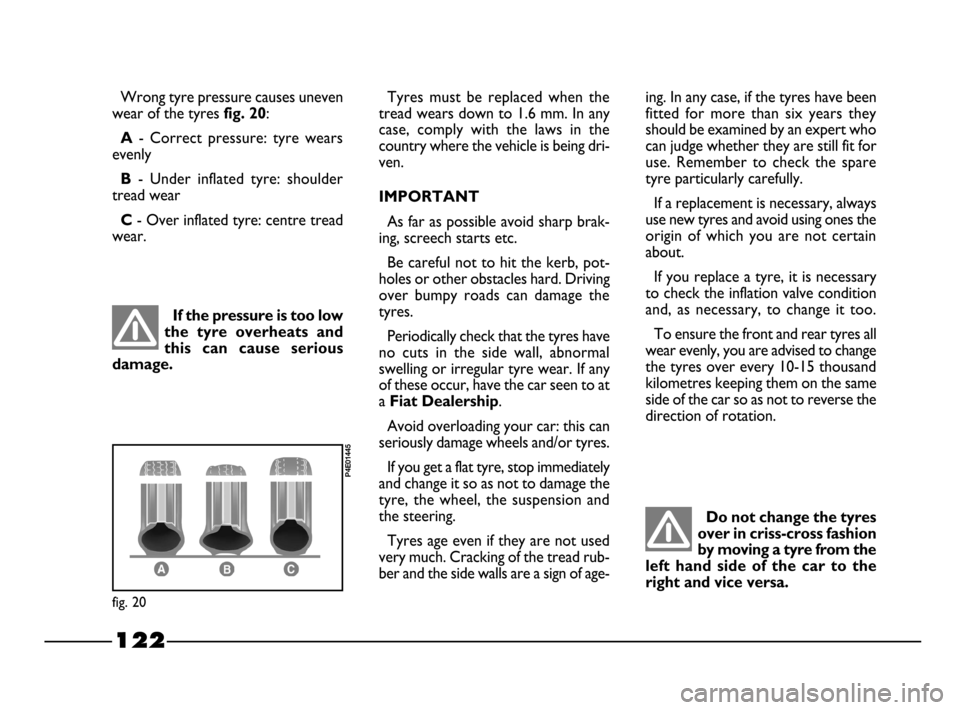
122
Do not change the tyres
over in criss-cross fashion
by moving a tyre from the
left hand side of the car to the
right and vice versa.
Wrong tyre pressure causes uneven
wear of the tyres
fig. 20:
A- Correct pressure: tyre wears
evenly
B- Under inflated tyre: shoulder
tread wear
C- Over inflated tyre: centre tread
wear. Tyres must be replaced when the
tread wears down to 1.6 mm. In any
case, comply with the laws in the
country where the vehicle is being dri-
ven.
IMPORTANT
As far as possible avoid sharp brak-
ing, screech starts etc.
Be careful not to hit the kerb, pot-
holes or other obstacles hard. Driving
over bumpy roads can damage the
tyres.
Periodically check that the tyres have
no cuts in the side wall, abnormal
swelling or irregular tyre wear. If any
of these occur, have the car seen to at
a
Fiat Dealership.
Avoid overloading your car: this can
seriously damage wheels and/or tyres.
If you get a flat tyre, stop immediately
and change it so as not to damage the
tyre, the wheel, the suspension and
the steering.
Tyres age even if they are not used
very much. Cracking of the tread rub-
ber and the side walls are a sign of age-
If the pressure is too low
the tyre overheats and
this can cause serious
damage.
fig. 20
P4E01445
ing. In any case, if the tyres have been
fitted for more than six years they
should be examined by an expert who
can judge whether they are still fit for
use. Remember to check the spare
tyre particularly carefully.
If a replacement is necessary, always
use new tyres and avoid using ones the
origin of which you are not certain
about.
If you replace a tyre, it is necessary
to check the inflation valve condition
and, as necessary, to change it too.
To ensure the front and rear tyres all
wear evenly, you are advised to change
the tyres over every 10-15 thousand
kilometres keeping them on the same
side of the car so as not to reverse the
direction of rotation.
104-127 03/03/2003 06:53 PM Page 122
Page 128 of 156
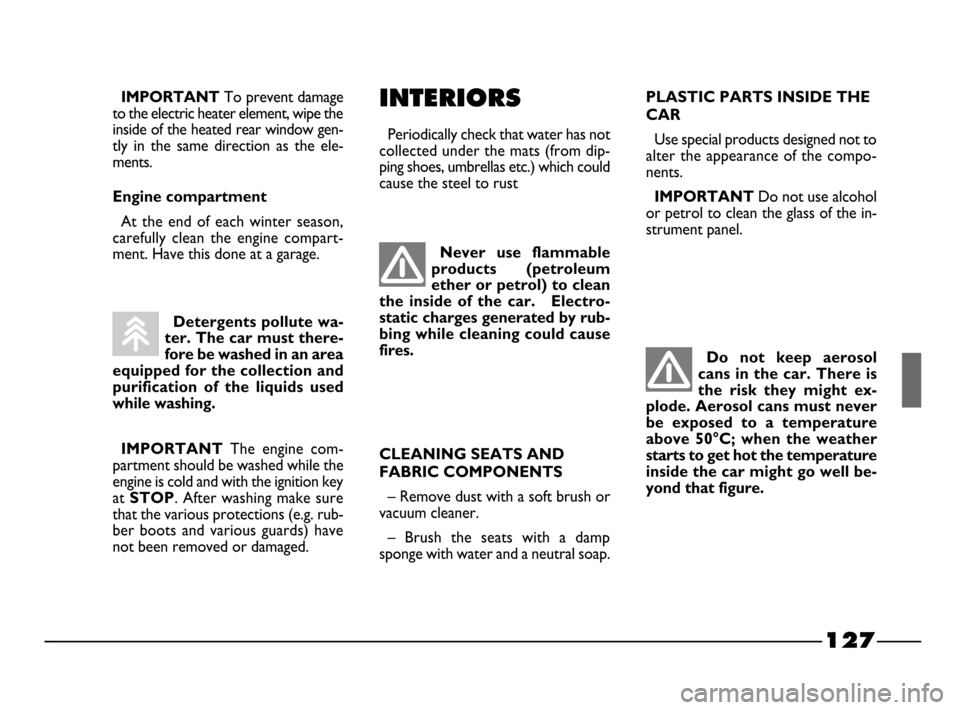
127
Detergents pollute wa-
ter. The car must there-
fore be washed in an area
equipped for the collection and
purification of the liquids used
while washing.
IMPORTANT
The engine com-
partment should be washed while the
engine is cold and with the ignition key
at
STOP. After washing make sure
that the various protections (e.g. rub-
ber boots and various guards) have
not been removed or damaged.
IMPORTANTTo prevent damage
to the electric heater element, wipe the
inside of the heated rear window gen-
tly in the same direction as the ele-
ments.
Engine compartment
At the end of each winter season,
carefully clean the engine compart-
ment. Have this done at a garage.
INTERIORS
Periodically check that water has not
collected under the mats (from dip-
ping shoes, umbrellas etc.) which could
cause the steel to rust
CLEANING SEATS AND
FABRIC COMPONENTS
– Remove dust with a soft brush or
vacuum cleaner.
– Brush the seats with a damp
sponge with water and a neutral soap.
Never use flammable
products (petroleum
ether or petrol) to clean
the inside of the car. Electro-
static charges generated by rub-
bing while cleaning could cause
fires.
Do not keep aerosol
cans in the car. There is
the risk they might ex-
plode. Aerosol cans must never
be exposed to a temperature
above 50°C; when the weather
starts to get hot the temperature
inside the car might go well be-
yond that figure.
PLASTIC PARTS INSIDE THE
CAR
Use special products designed not to
alter the appearance of the compo-
nents.
IMPORTANTDo not use alcohol
or petrol to clean the glass of the in-
strument panel.
104-127 03/03/2003 06:53 PM Page 127